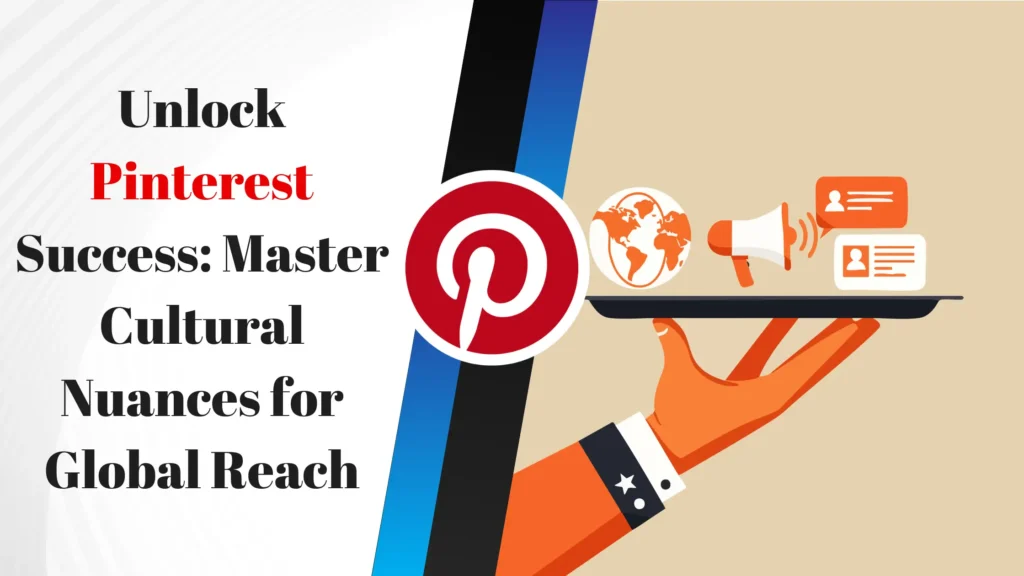Unlock Pinterest Success: Master Cultural Nuances for Global Reach
Want to make your Pinterest game strong, like seriously strong? Then listen up! It’s not just about pretty pictures and catchy descriptions. To truly succeed, especially if you’re aiming for a global audience, you’ve got to understand cultural nuances. Think of it like this: what works wonders in the US might completely flop in Japan. Why? Because culture shapes how people think, what they like, and how they interact with content. So, how do you crack the code? Let’s dive in!

Why Cultural Sensitivity Matters on Pinterest
Imagine walking into a foreign country and accidentally insulting someone because you didn’t understand their customs. Awkward, right? The same can happen on Pinterest if you ignore cultural differences. You might unintentionally offend potential customers, damage your brand reputation, or simply fail to connect with your target audience. Cultural sensitivity isn’t just a nice-to-have; it’s a business imperative. If you want to truly make a mark you need to be mindful of these things.
Why should you even bother? Well, for starters, a culturally aware Pinterest strategy helps you build stronger relationships with your followers. When people feel understood and respected, they’re more likely to engage with your content, share it with their friends, and ultimately, become loyal customers. It’s about making a genuine connection, not just pushing products. Plus, by understanding cultural nuances, you can tailor your content to resonate with specific audiences, leading to higher engagement rates and better ROI. Sounds good, doesn’t it?
Key Cultural Considerations for Pinterest Marketing
Okay, so what exactly do you need to consider? Here are a few crucial areas to focus on:
Language and Localization
This one’s a no-brainer, but it’s worth emphasizing: speak your audience’s language. Don’t just rely on Google Translate! Hire professional translators who understand the cultural context of your target market. Localization goes beyond just translating words; it’s about adapting your content to fit the local culture. This means considering things like idioms, slang, and even the tone of voice you use. A playful, humorous tone might work well in some cultures, but come across as disrespectful in others.
For example, consider a simple phrase like “best of luck.” While widely understood in English-speaking countries, its direct translation might not convey the same sentiment in another language. A skilled translator would adapt the phrase to something that resonates more naturally with the local audience, ensuring the message is both accurate and culturally appropriate. Don’t underestimate the power of language, and don’t be afraid to invest in professional translation services.
Visuals and Imagery
Images speak louder than words, especially on a visual platform like Pinterest. But be careful! What’s considered beautiful or appealing in one culture might be completely different in another. Think about things like:
- Colors: Colors have different meanings in different cultures. For example, white is often associated with purity and weddings in Western cultures, but it’s a symbol of mourning in many Asian countries.
- Symbols: Certain symbols can be offensive or taboo in some cultures. Avoid using symbols that could be misinterpreted or cause offense.
- People: Representation matters! Make sure your images feature diverse people who reflect the demographics of your target audience. Consider skin tones, clothing styles, and cultural backgrounds.
- Aesthetics: Beauty is in the eye of the beholder, and cultural preferences play a huge role in what people find aesthetically pleasing. Research the visual trends and styles that are popular in your target market.
For instance, if you’re promoting a beauty product in India, using images of women with traditional Indian features and clothing would be far more effective than using images of Western models. Similarly, if you’re targeting a conservative culture, avoid using overly revealing or suggestive imagery.
Values and Beliefs
Understanding the values and beliefs of your target audience is crucial for creating content that resonates with them on a deeper level. Consider things like:
- Religion: Be respectful of religious beliefs and avoid using imagery or language that could be considered offensive or sacrilegious.
- Traditions: Learn about important cultural traditions and holidays, and tailor your content accordingly. For example, you could create Pinterest boards featuring recipes or decorating ideas for specific holidays.
- Social Norms: Be aware of social norms and customs, and avoid content that could be seen as disrespectful or inappropriate.
- Family Values: In many cultures, family is highly valued. Incorporate images and messages that celebrate family and community.
Imagine you’re promoting a travel package. Instead of just focusing on the luxurious aspects of the trip, highlight the opportunity to experience new cultures, learn about local traditions, and create lasting memories with loved ones. This approach would resonate more strongly with cultures that place a high value on family and personal growth.
Humor and Tone
Humor is a tricky thing because it is so highly subjective. What’s funny in one culture might be completely lost or even offensive in another. Be very careful when using humor in your Pinterest marketing, and always err on the side of caution. When in doubt, avoid using humor altogether.
Similarly, pay attention to the overall tone of your content. A casual, informal tone might work well in some cultures, but come across as unprofessional or disrespectful in others. Research the communication styles that are common in your target market and adapt your tone accordingly. A good place to start is understanding more about the customer.
Practical Tips for Implementing a Culturally Sensitive Pinterest Strategy
Alright, enough theory! Let’s get down to brass tacks. Here are some actionable tips for implementing a culturally sensitive Pinterest strategy:
- Do Your Research: Before launching any Pinterest campaign, take the time to thoroughly research your target audience. Learn about their language, culture, values, and beliefs.
- Use Local Experts: Partner with local experts, such as translators, marketers, and cultural consultants, to ensure your content is culturally appropriate.
- Test Your Content: Before publishing any content, test it with a small group of people from your target audience to get their feedback. This will help you identify any potential issues before they become a problem.
- Monitor Your Results: Keep a close eye on your Pinterest analytics to see how your content is performing in different markets. Use this data to refine your strategy and optimize your results.
- Be Open to Feedback: Encourage your followers to provide feedback on your content, and be open to making changes based on their suggestions.
Think of it like baking a cake. You wouldn’t just throw a bunch of ingredients together without following a recipe, would you? Similarly, you can’t expect to succeed in global Pinterest marketing without doing your homework and understanding your audience.
Examples of Successful Culturally Sensitive Pinterest Campaigns
Want some inspiration? Here are a few examples of brands that have successfully implemented culturally sensitive Pinterest campaigns:
- Airbnb: Airbnb has created Pinterest boards featuring unique travel experiences in different countries, showcasing the local culture and traditions.
- Dove: Dove has featured models of all shapes, sizes, and ethnicities in their Pinterest campaigns, promoting a message of body positivity and inclusivity.
- McDonald’s: McDonald’s has adapted its menu and marketing to suit local tastes in different countries, creating Pinterest boards featuring regional specialties.
These brands understand that one size doesn’t fit all when it comes to Pinterest marketing. They’ve taken the time to understand their target audiences and create content that resonates with them on a cultural level.
The Future of Cultural Nuances in Pinterest Marketing
As the world becomes increasingly interconnected, the importance of cultural sensitivity in Pinterest marketing will only continue to grow. Brands that embrace cultural nuances and prioritize inclusivity will be the ones that thrive in the global marketplace.
So, what’s next? Expect to see more sophisticated AI-powered tools that can help marketers identify and address cultural biases in their content. Look for more personalized and localized experiences on Pinterest, tailored to the specific needs and preferences of individual users. And above all, remember that cultural sensitivity is not just a marketing strategy; it’s a way of doing business that builds trust, fosters relationships, and creates a more inclusive world.
Are you ready to take your Pinterest marketing to the next level? Start by embracing cultural nuances and creating content that truly connects with your global audience. Good luck!










